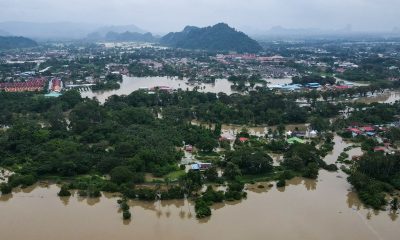International
Ukraine finds in technology its best ally for war

Ukraine has found in technology its best ally for war, with a commitment to innovation that makes the difference both on the battlefield and in the daily lives of millions of citizens who have to live with the invasion.
In a conflict that from the beginning has been compared to a fight between David and Goliath, the “slingshot” of Ukraine is technology: hybrids between a missile and a drone to accurately attack Russian bases, robots that evacuate wounded soldiers or kamikaze devices that destroy bridges.
Machines to support troops
“We are trying to fight them with machines because we do not have enough people,” explained the Ukrainian Deputy Minister of Digital Transformation, Alex Bornyakov, in an interview with EFE during the Web Summit, the technology congress held this week in Lisbon.
This commitment to technological innovation allowed Ukraine to destroy part of the Russian fleet in the Black Sea with small kamikaze ships, an “exact example” of the metaphor between David and Goliath, the deputy minister said.
Ukrainian forces also use sentinel drones to monitor a territory, capable of attacking the enemy if necessary; robots that help evacuate soldiers so as not to endanger other companions; and autonomous devices to locate and extract mines.
This year the biggest bet is drone missiles, such as the Palianytsia, with a flight range of between 500 and 700 kilometers and which can be used against targets in Russian territory.
“By next year we are definitely going to produce more of our own missiles,” explained Bornyakov, who explained that the budget for the purchase of drones is around 3,000 or 4 billion dollars.
In addition, they will allocate another 80 million to innovations in Defense.
Technology for day to day
These efforts are not only aimed at the battlefield but also at using technology to help Ukrainians live with the war on a daily basis.
An example is ‘Kiev Digital’, the mobile application that the City Council of the Ukrainian capital launched in 2021 and that since the invasion has become indispensable for the Kievites.
“We notify people that a missile attack is coming. We offer you additional information about where the bomb shelters are, where the target of the attack is, which shelters have Wi-Fi and how to get there,” Oleg Polovynko, who advises the consistory on digitization issues, exemplified to EFE.
The app reports on other consequences of the war such as power cuts but also on the basic services of any city, such as the transport network or online procedures.
18% of the population uses it daily and about 40% weekly, said Polovynko, who assured that Kiev is already a global reference in digital transformation and “all cities have to learn” from it.
Objective: to boost the technological ecosystem
The Ukrainian technological ecosystem is present this year at the Web Summit with more than 80 start-ups, some of them oriented to the Defense sector, such as BeesAM and RMachine, specialized in mines.
Others, such as Inheart.memorial, are dedicated to helping to remember and honor the deceased, with a platform to make digital memorials that allows you to gather biographies, photographs, videos, links to social networks and other resources.
Then a QR is created that is placed next to the tombstones, so that anyone can know their story.
Although the idea emerged before the war, it now includes many pages dedicated to the “heroes,” the CEO of the platform, Oleksander Sydorov, explained to EFE, who pointed out that they have added new features such as the last battle or the medals received.
Promoting the technological ecosystem was already one of the purposes of the Ukrainian Government in 2019, before the invasion, as the deputy minister recalled: “We set ourselves the goal of becoming one of the leading technological hubs in Europe.” The war has accelerated the process.
International
El Chapo’s son Joaquín Guzmán López pleads guilty to U.S. drug trafficking charges

Joaquín Guzmán López, one of the sons of notorious Mexican drug lord Joaquín “El Chapo” Guzmán, pleaded guilty on Monday to drug trafficking charges in a U.S. court, months after his brother Ovidio reached a similar plea agreement, according to local media reports.
The defendant appeared before a federal court in Chicago early Monday afternoon and changed his previous plea in the case, the Chicago Tribune reported. U.S. authorities accuse him of forming, together with his three brothers, the cartel faction known as “Los Chapitos.”
The group is believed to have continued the operations of El Chapo, who has been serving a life sentence in the United States since 2019.
Guzmán López, 39, was arrested after landing in Texas in a small aircraft alongside cartel co-founder Ismael “El Mayo” Zambada.
International
Venezuela authorizes return flights as U.S. continues deportations amid rising tensions

The arrival of U.S. aircraft carrying undocumented Venezuelan migrants continued regularly despite rising tensions between Washington and Caracas over President Donald Trump’s military deployment in the Caribbean.
Trump maintains that the deployment is part of an anti-narcotics operation, while Venezuelan President Nicolás Maduro insists the true objective is to remove him from power and seize the nation’s oil resources.
Venezuela’s aviation authority has “received a request from the United States government to resume repatriation flights for Venezuelan migrants from that country to Venezuela,” the Ministry of Transportation said in a statement .
“Under the instructions of President Nicolás Maduro, authorization has been granted for these aircraft to enter our airspace,” it added.
Caracas will permit two Eastern Airlines flights to land on Wednesday and Friday.
Migration remains one of the Trump administration’s flagship issues. On Monday, the U.S. president held a meeting with his National Security Council to discuss the situation in Venezuela, a day after confirming he had spoken with Maduro by phone, without offering further details.
According to the Venezuelan government, roughly 75 deportation flights have been carried out this year, returning at least 13,956 Venezuelans from the United States.
International
20,000 rounds stolen from german army after driver leaves cargo unattended

The German army confirmed the theft of a shipment of ammunition that occurred a week ago while it was being transported by a civilian delivery driver, a military spokesperson told AFP, confirming earlier media reports.
According to Der Spiegel and the regional broadcaster MDR, around 20,000 rounds of ammunition were stolen from an unguarded parking lot near Magdeburg, in eastern Germany, while the driver was asleep in a nearby hotel. No information has been released regarding the identity of the suspects, and the military declined to specify the exact type or amount of ammunition taken.
Authorities have also not indicated how the perpetrators knew the cargo would be left unattended.
“The theft was discovered upon delivery at the barracks,” the German army spokesperson said.
A police spokeswoman confirmed to AFP that an investigation has been opened but refused to provide further details “for tactical reasons.”
Sources close to the German military, cited by Der Spiegel, believe it is unlikely the theft was a coincidence. They suspect the thieves waited for the driver to stop for the night before striking.
Der Spiegel also reported that the Defense Ministry normally requires two drivers for this type of transport to ensure the cargo is constantly monitored. However, in this case only one driver was assigned, meaning the civilian transport company failed to comply with the security protocols.
-

 Central America4 days ago
Central America4 days agoTrump Pardons Former Honduran President Hernández and Warns of Aid Cuts Ahead of Election
-

 Central America3 days ago
Central America3 days agoHonduras Extends Voting by One Hour Amid High Turnout, CNE Announces
-

 International2 days ago
International2 days agoHong Kong police arrest 13 over deadly high-rise fire that killed 151
-

 Central America3 days ago
Central America3 days agoHonduras’ China–Taiwan Future Hinges on Sunday’s Presidential Election
-

 International4 days ago
International4 days agoMeta Says Russia Seeks to Ban WhatsApp for Defending Secure Communication
-

 International2 days ago
International2 days agoSri Lanka and Indonesia deploy military as deadly asian floods kill over 1,000
-

 International2 days ago
International2 days agoTrump says asylum decision freeze will remain in place “for a long time”
-

 International2 days ago
International2 days agoChile enters runoff campaign with Kast leading and Jara seeking a last-minute comeback
-

 International22 hours ago
International22 hours ago20,000 rounds stolen from german army after driver leaves cargo unattended
-

 International22 hours ago
International22 hours agoVenezuela authorizes return flights as U.S. continues deportations amid rising tensions
-

 International22 hours ago
International22 hours agoEl Chapo’s son Joaquín Guzmán López pleads guilty to U.S. drug trafficking charges
-

 International23 hours ago
International23 hours agoTrump convenes National Security Council as U.S.–Venezuela tensions intensify






























